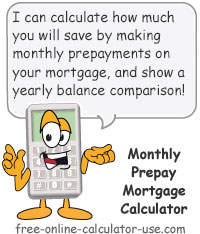IMPORTANT: Numeric entry fields must not contain dollar signs, percent signs, commas, spaces, etc. (only digits 0-9 and decimal points are allowed).
Click the Terms tab above for a more detailed description of each entry.
Step #1:
Enter the original mortgage principal amount.
Step #2:
Enter the mortgage's annual interest rate.
Step #3:
Enter the original loan term in the number of years (whole years only).
Step #4:
Enter the number of mortgage payments you have already made.
Step #5:
Enter the monthly prepayment amount you can afford to add to your current payment.
Step #6:
Click the "Calculate Prepayment Savings" button.


Follow me on any of the social media sites below and be among the first to get a sneak peek at the newest and coolest calculators that are being added or updated each month.